From Focaccia to Fuel
Irvine, Calif., Nov. 5, 2007 -- For thousands of years, a common yeast strain has been used to make bread, beer and wine. Now, unique research underway in the Calit2 Building at UC Irvine aims to transform it into something more: an efficient producer of ethanol to help meet the nation’s increasing thirst for “green” energy.
Scientists in the Computational Biology Research Lab (CBRL) are collaborating with researchers in the schools of information and computer sciences, engineering and medicine, and researchers at CODA Genomics, an Orange County synthetic biology company. They are working on a new way to make the clean, environmentally safe fuel.
|
As the United States searches for environmentally friendly ways to reduce its dependence on foreign oil, ethanol has emerged as a possible option. It is high octane, clean burning and renewable.
Problem is, it’s difficult to produce and in the past, has derived primarily from corn. UCI and CODA Genomics researchers are collaborating to tweak the genetic structure of a yeast strain called Saccharomyces so that it can produce ethanol more efficiently and from additional sources of biomass – switchgrass, hemp, wood and other natural materials.
Modifying Genetics
Saccharomyces produces ethanol as a byproduct when it ferments glucose found in plant materials. But it does not contain the necessary enzymes to process other sugars in biomass, such as xylose and arabinose.
|
Researchers are using CODA Genomics’ patented gene-protein-production algorithms to modify the yeast’s genetic structure. The re-engineered version will produce enzymes that allow it to digest other sugars as easily as glucose, maximizing its ability to produce ethanol.
Current production methods make use of approximately 20 percent of the sugars in corn ‘stover’ – the dried stalks and leaves that are left after harvesting. Plus, the most widely used methods employ fossil fuels to break down the stover and separate the sugars before processing.
Scientists believe this new version of Saccharomyces will use 80-90 percent of the sugars in a much wider variety of biomass to produce ethanol. And it will do so unaided, avoiding expensive, carbon-emitting procedures.
“While there currently are yeast strains that can make ethanol from biomass, the existing process is very expensive and inefficient. We’re trying to build a better yeast strain – one that can produce more ethanol from the same amount of biomass by breaking it down naturally,” says G. Wesley Hatfield, professor emeritus, principal investigator on the project and a CODA Genomics co-founder.
The $1.67 million research collaboration began Sept. 1 and is funded by CODA and a UC Discovery Grant that provides matching funds for innovative industry-university research partnerships.
Multidisciplinary Endeavor
CODA, which spun off in 2005 from UCI research, sells kits that manufacture synthetic genes. Its biggest customers have been pharmaceutical and biomedical companies that use them to develop and test new drugs.
The company’s patented technology uses computer algorithms to design the genes to self-assemble easily and generate protein in large amounts, allowing them to be re-engineered to meet the needs of different organisms. When applied to Saccharomyces, the technology modifies the yeast so it can manufacture additional enzymes that can break down more sugars.
Even when the yeast produces the necessary enzymes, inefficiencies in its metabolic pathways can slow the process. Pierre Baldi, director of UCI’s Institute for Genomics and Bioinformatics (IGB) and a co-principal investigator, is computationally “optimizing” key enzymes to increase their efficiency. With computer algorithms, he is engineering compatibility of these key enzymes with various co-factors – the small molecules that help the enzymes work. Baldi is also Chancellor’s Professor in the Donald Bren School of Information and Computer Sciences.
“Given the current energy crisis and global warming concerns, we are excited about the potential outcome,” says Baldi.
Also involved in the multidisciplinary project are IGB faculty members Suzanne Sandmeyer, from the School of Medicine’s Department of Biological Chemistry, and Nancy Da Silva, from the engineering school’s Department of Chemical Engineering and Materials Science.
CBRL scientists perform the computation, gene design and gene assembly of the yeast proteins using CODA’s technology. Sandmeyer and Da Silva insert the optimized genes into the yeast genome, ensuring the enzymes’ stability and ability to function. They also make certain that fermentation conditions are optimal to maximize ethanol production.
Future Energy
The biofuels team brims with confidence about the project’s potential. “We already have made important advances towards the key issues,” says project scientist Kirsty Salmon. “We hope to have even more enabling results in the coming months.”
Robert Molinari, CODA Genomics founding CEO, is pleased that the company’s expertise might lead to the development of more efficient energy producing methods.
“The CODA technology is already showing commercial success in therapeutic protein markets,” he says. “Now we are going to apply the unique approach to a large national problem.”


